Beautyberry (Callicarpa Americana) Grow & Care Guide
Written by Iris
Nov 13 2021
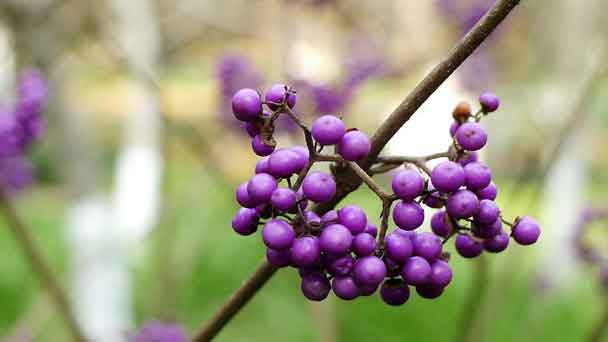
Beautyberry (Callicarpa americana) blooms throughout the summer, producing clusters of pink to purple flowers. As beautiful as the berries, the flowers of this shrub have no significant landscape value. Once the flowers are pollinated and formed into berries, Beautyberry is sure to be the belle of the ball.
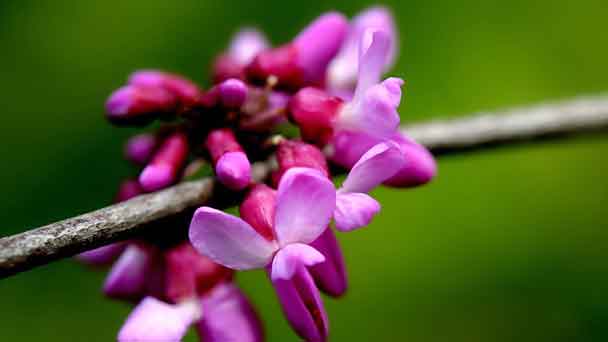
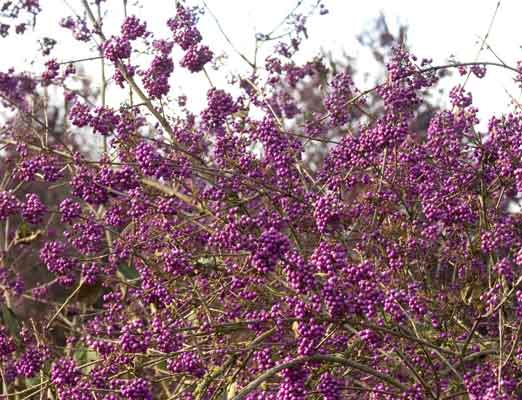
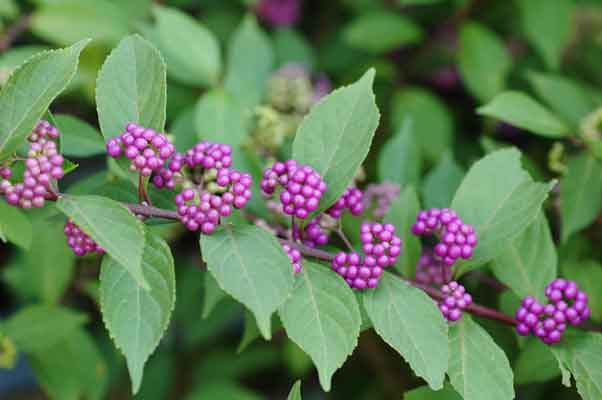
Sanitize pruning tools between each cut by dipping them into a solution of 1 part household bleach and 9 parts water. Although beautyberry bushes generally don't suffer from insect infestations or plant diseases, sanitary tools help prevent spreading the occasional problem.
'Bodinier's beautyberry' (Callicarpa bodinieri): Bodinier's beautyberry is native to China and grows to around 10 feet tall by 8 feet wide. Like the American beautyberry, Bodinier's beautyberry also produces purple berries. But Bodinier's beautyberry is more cold tolerant than the American version.
'Japanese beautyberry' (Callicarpa japonica): This shrub is native to Japan and reaches around 4 to 6 feet tall and wide. Japanese beautyberry produces clusters of bright purple berries.
'Chinese beautyberry' (Callicarpa dichotoma): This shrub is native to China, Japan, and Korea, and it too produces purple fruits. chinese beautyberry reaches between 2 to 4 feet tall and 3 to 5 feet wide.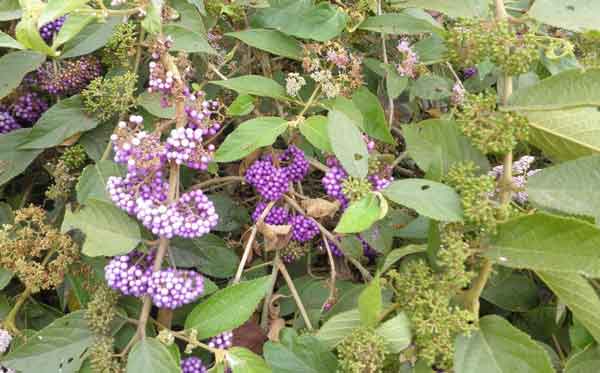
Read Next:
Top 30 Fall Flowers to Plant - Beautiful Autumn Flowers
30 Fall Plants for a Beautiful Fall Garden
Where to Grow BeautyberryHow to Grow Beautyberry (Callicarpa americana)Grow Beautyberry from SeedsGrow Beautyberry from CuttingsHow to Care for Beautyberry (Callicarpa americana)Beautyberry Lighting RequirementsBeautyberry Soil CareBeautyberry WateringBeautyberry Temperature & Humidity CareBeautyberry FertilizerBeautyberry PruningBeautyberry SpacingBeautyberry Pests & Diseases CareBeautyberry VarietiesBeautyberry (Callicarpa americana) FAQIs Beautyberry Edible?Is beautyberry invasive?
Where to Grow Beautyberry
Beautyberry (Callicarpa americana) will fruit best when planted in an area of partial shade – such as in a glade, beneath the dappled shade of a deciduous tree, or close to the fringes of a forest or woodland garden. However, Beautyberry can also do well where no shade is available, as long as the soil does not dry out too much. Beautyberry will grow best in well-drained but moist soil – ideally a loamy (medium) one. Beautyberries are not too fussy when it comes to soil pH.
How to Grow Beautyberry (Callicarpa americana)
Grow Beautyberry from Seeds
If growing from seed, soak the seeds in clean, cool water for 24 hours. If you want to start seeds indoors, sow 1/16-inch deep in small pots or seedling trays filled with seed-starter potting mix. Place trays or pots in a warm, sunny area. Keep the soil lightly moist via a spray-bottle mister until the seedlings are transplant size, about three months after sowing. This plant also liberally reseeds itself. For direct sowing, you can sow seeds in fall, before first frost or in spring, after all danger of frost has passed.Grow Beautyberry from Cuttings
You can propagate beautyberry from softwood cuttings in spring. Softwood is a stem that is not brand new nor old and woody. Cut four- to six-inch stems from a healthy plant. Fill small pots with an all-purpose soil mix and insert and remove a pencil to create a hole for the cutting. Remove the lower leaves from your cutting, dip the cleanly cut end into rooting hormone and place in the hole. Create a mini greenhouse by placing a plastic dome or clear plastic bag over the pot or pots. Put it in bright, indirect light.
How to Care for Beautyberry (Callicarpa americana)
Beautyberry Lighting Requirements
Beautyberry plants prefer full to partial sun. While they produce more berries in full sun, beautyberry is naturally suited to the edges of woodland areas. The more sun plants receive, the more water they will need.Beautyberry Soil Care
Beautyberry are not to finicky regarding soil type. That said, they prefer a moist but well drained soil of average fertility. As with many other ornamental plants, a constantly wet soil can be problematic. Beautyberry grow best in an acid to neutral soil ranging from 5.0 to 7.0 on the pH scale. Most average garden soils fall between a pH range of 6.0 to 7.0.Beautyberry Watering
Although established beautyberries can tolerate some drought, under extreme conditions they may drop their leaves and berries to compensate for the lack of moisture. For the best performance, be sure to maintain consistent soil moisture, giving your shrubs about an inch of water per week during prolonged dry spells. (Find more fall plants here.)Beautyberry Temperature & Humidity Care
Beautyberry shrubs thrive throughout their hardiness zones and don't have any particular temperature or humidity requirements. A layer of mulch around the base of the shrub can help to keep its roots at a consistent temperature, which will benefit the shrub's overall health.
Beautyberry Fertilizer
Feed the beautyberry shrub a complete 16-4-8 fertilizer in the spring and about midsummer. Lightly sprinkle about 2 tablespoons of fertilizer around the Beautyberry shrub, staying about 6 inches away from the Beautyberry plant and spreading the product out just beyond the drip line.Beautyberry Pruning
Prune the Beautyberry shrub in late winter or early spring before new growth appears. Use hand pruners or lopping shears to remove damaged or dead branches, cut out old wood and thin out crowded interiors. Cut off branches about 1/4 inch above buds or lateral branches.Sanitize pruning tools between each cut by dipping them into a solution of 1 part household bleach and 9 parts water. Although beautyberry bushes generally don't suffer from insect infestations or plant diseases, sanitary tools help prevent spreading the occasional problem.
Beautyberry Spacing
When planting beautyberry, give it plenty of room to sprawl. The weight of the berries often cause the shrub's flexible branches to bend, which can shade or crowd nearby plantings. As a general rule of thumb, space plants about 5 to 7 feet apart.Beautyberry Pests & Diseases Care
The only known beautyberry pests are the animals that enjoy the Beautyberry. You may see minor leaf spots (Atractilina callicarpae) or black mold (Meliola cookeana), which can be treated with a fungicide.Beautyberry Varieties
Besides the American beautyberry (Callicarpa americana), some other species of beautyberry include:'Bodinier's beautyberry' (Callicarpa bodinieri): Bodinier's beautyberry is native to China and grows to around 10 feet tall by 8 feet wide. Like the American beautyberry, Bodinier's beautyberry also produces purple berries. But Bodinier's beautyberry is more cold tolerant than the American version.
'Japanese beautyberry' (Callicarpa japonica): This shrub is native to Japan and reaches around 4 to 6 feet tall and wide. Japanese beautyberry produces clusters of bright purple berries.
'Chinese beautyberry' (Callicarpa dichotoma): This shrub is native to China, Japan, and Korea, and it too produces purple fruits. chinese beautyberry reaches between 2 to 4 feet tall and 3 to 5 feet wide.

Beautyberry (Callicarpa americana) FAQ
Is Beautyberry Edible?
Yes, but the berries of American beautyberry aren't particularly tasty though you could use them to make jelly. Apparently many berry-eating critters aren't wild about the taste either, usually feeding on them later in winter - and giving us more time to enjoy their color in our landscapes.Is beautyberry invasive?
Beautyberry will readily self-sow. Check with local experts to see if this poses a threat where you live, or learn more about where beautyberry may be considered invasive.Read Next:
Top 30 Fall Flowers to Plant - Beautiful Autumn Flowers
30 Fall Plants for a Beautiful Fall Garden
Latest Updated
- Benefits of Bugleweed - 7 Science-backed Health Benefits
- Bugleweed Dangers & Side Effects - Is It Poisonous?
- How to Plant Evergreen Trees - What You Should Know
- When to Plant Evergreens - Grow Guide for Evergreen Trees
- 12 Wonderful Evergreen Shrubs for Your Garden
- 12 Popular Evergreen Plants with Pictures for Beginners
- When And How To Prune A Lilac Bush Like a Pro
- How to Grow & Care for Lilac Vine (Hardenbergia Violacea)
- Japanese Lilac Tree (Syringa Reticulata) Care & Propagation Guide
- Shumard Oak Pros and Cons - What to Know
Popular Articles
- Winter maintenance of Antirrhinum Majus
- How to Grow Terminalia Mantaly Tree
- How to Grow and Care for Crossostephium Chinense
- How to grow Antirrhinum Majus in spring
- Peristeria Elata (Dove Orchid) Profile: Info & Care Guide
- Underwatered Snake Plant (Sansevieria Trifasciata) - Signs And How To Fix
- How to Care for Brazilian Jasmine Plant (Mandevilla Sanderi)
- How to Grow & Care for Graptopetalum Purple Delight in Summer
- Rosa Chinensis (China Rose): Plant Growing & Care Tips
- How to Care for Baby Sun Rose (Aptenia Cordifolia)